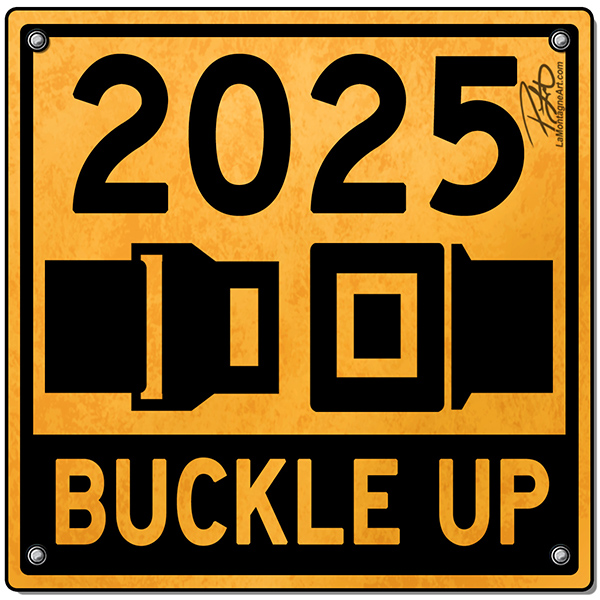
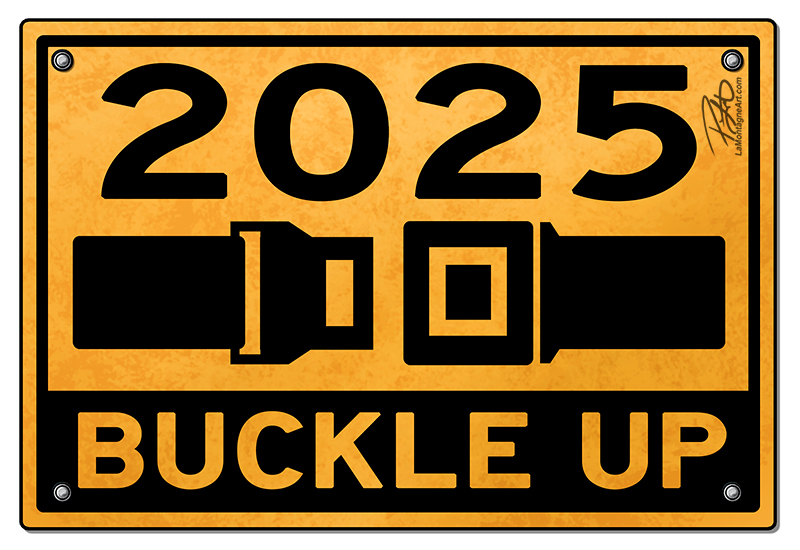 New subscribers usually follow me for my whimsical wildlife art. They’re often unaware that half of my business, about 40% these days, is drawing syndicated editorial cartoons for daily and weekly newspapers in several Canadian provinces. In addition to painting my wildlife art, I draw six or seven cartoons each week.
New subscribers usually follow me for my whimsical wildlife art. They’re often unaware that half of my business, about 40% these days, is drawing syndicated editorial cartoons for daily and weekly newspapers in several Canadian provinces. In addition to painting my wildlife art, I draw six or seven cartoons each week.
A short time ago, I wrote a post about my disappointment at the outcome of the US election. For my email subscribers, I prefaced it with a clear statement that the narrative they were about to read was political. I suggested that subscribers who’d rather not read that opinion piece could close the email, and I’d have something more up-tempo for them later.
Of course, one subscriber who kept reading (his choice) and didn’t like it, sent me an email that read, “Nobody cares about your TDS, JUST DRAW PICTURES. I am embarrassed to own your art work now, stop it.”
TDS means Trump Derangement Syndrome. I had to look it up.
The loudest advocates for freedom of speech are almost always talking exclusively about their own. Because I long ago learned the lessons about the futility of online arguments, I didn’t respond, and he unsubscribed.
Though the following is not political, it’s not upbeat. It’s not a New Year’s post that this will be the best year ever! Some might consider it dark and sombre as it puts a harsh spotlight on the fact that we each have an expiry date, and none of us knows when that is.
If you’re not up for that kind of read, this is your exit. Drive safely. We can meet up a little further down the road.
Still here? Your call.
I saw a news article this week titled The Celebrities We Lost in 2024. Many on the list I hadn’t heard about their passing or had forgotten I’d seen it. True to my nature, I noted each cause of death. It happens once you reach a certain age; you realize that, yeah, it’s coming. Unfortunately, I began ruminating on my pending demise years earlier than I should have, a consequence of OCD and anxiety issues.
I’m not afraid of death. I imagine, for many, it’s like going to sleep. You’re awake, then you’re not. Out, brief candle, and all that. If there’s something afterward, I’ll find out then. I am, however, terrified of failing health, physical infirmity and cognitive decline. The shit you think only happens to other people can and will happen to you or those you care about.
I am also afraid of regret, a life unlived, and unrealized potential.
I don’t care if I’m remembered. Most of us aren’t. I once read a conversation where the question was asked, “What was your grandfather’s name?”
Upon receiving the answer, the follow-up question was, “What was his grandfather’s name?”
Very few of us could answer the second question correctly, and that’s the point.
If I’m going to be here, and if it doesn’t matter much in the cosmic timeline, I’d like to do something worthwhile, or at least fool myself into thinking so.
So far, I feel I haven’t. Sadly, that perspective means I’ll likely never feel like I’ve done enough because I couldn’t even tell you what that means. Whatever laurels may come, I will never rest on them. Retirement doesn’t appeal to me. I need to keep busy. It’s the only way to turn the volume down on the noise in my head.
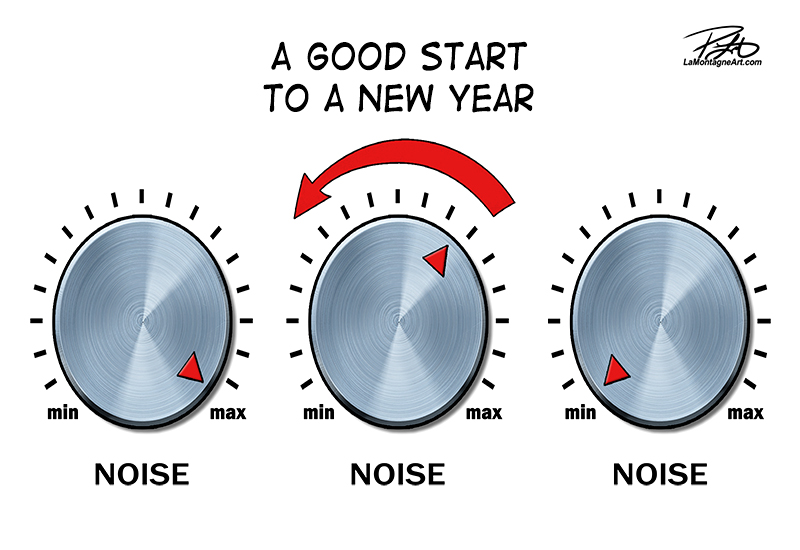 On that list of celebrity passings, for the ones that didn’t say, I found myself looking up their causes of death. Mostly, it was the usual suspects I don’t need to list. They’re the indignities of disease and illness that can strike any time but become more likely the longer we’re here.
On that list of celebrity passings, for the ones that didn’t say, I found myself looking up their causes of death. Mostly, it was the usual suspects I don’t need to list. They’re the indignities of disease and illness that can strike any time but become more likely the longer we’re here.
And I found myself looking at their ages; the ones that stood out were those around my own. We view the world from the space and time we occupy. I was once an arrogant 20-year-old who viewed 40 as something that happened to other people.
My Dad’s brother and their father both died at 53, the age I am now. While both were consequences of vice and bad habits, I didn’t realize how that fact has coloured my perspective for much of my adult life. Whether I registered it or not, I have long viewed my fifties as old age. Even though I am in good physical health (mental, the jury’s still out) and barring any skeletal spectre’s finger settling on my forehead, odds are I have many productive years ahead of me and miles to go before I sleep.
Regardless, I have long heard a ticking clock. And when the bell tolls, I won’t ask “Why me?”
It means I don’t often enjoy moments as they happen because I’m a pessimist by nature. I know that good or bad, young or old, fate does not have a conscience. It doesn’t discriminate.
My wife’s only sister was 20 years old when she died, thrown from a horse. She was an experienced rider, and it was bad luck that it happened in the wrong place. Five feet in any direction, and she might have been fine. It was a simple accident, and suddenly, she didn’t get to experience all the little things most of us take for granted.
And yet, some very nasty prominent people amass obscene fortunes through nefarious means, exploiting millions of people they’ll never meet and live well into their senior years. We might kid ourselves that money doesn’t buy happiness, but it sure as hell buys comfort and health care.
Life ain’t fair. Never has been.
So, while I may not always enjoy the little things as I should or stop and smell the roses, I have no delusions about my time here. It can end today or in forty years, likely in a manner I don’t see coming.
I know it’s an unhealthy perspective, but at the end of each year, I often look back with regret for the things I’ve wasted my time on. And for the failures, of which there are many, I take a deep breath and with a furrowed brow and through clenched teeth, resolve to try, try again in the year ahead.
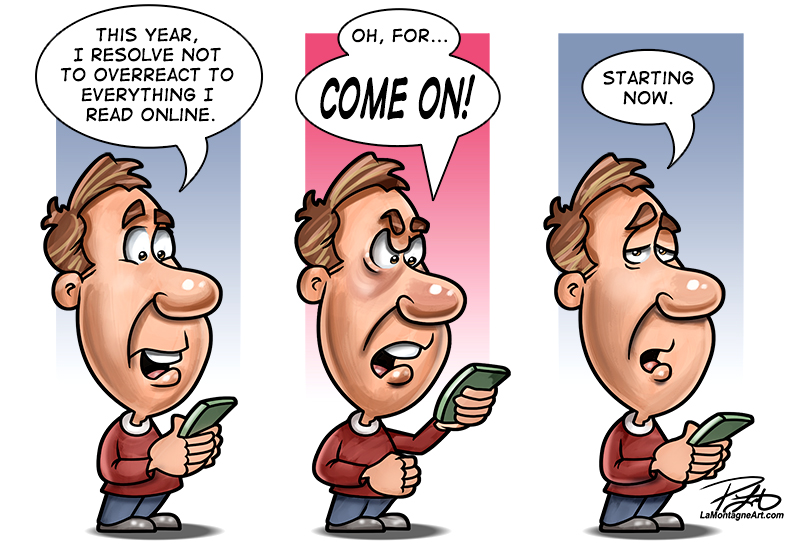 Though clichés and platitudes, there are lessons I clearly haven’t yet learned, that I’d do well to remember heading into 2025. Perhaps they’ll give you something to consider as well.
Though clichés and platitudes, there are lessons I clearly haven’t yet learned, that I’d do well to remember heading into 2025. Perhaps they’ll give you something to consider as well.
You can’t change other people. You can only change yourself. To many you know, your value is only what you can do for them, and they have assigned you a specific place and position in their life. You are the average of the five people you spend the most time with. Some want to see you grow. Others want you to stay right where you are.
Change never happens when you’re comfortable. Discomfort is often a necessary trigger to motivate sedentary people into action, especially when you’ve finally had enough of whatever you can no longer tolerate.
If you do the same things, you get the same results. Blame is easy. So are excuses.
Your job will be posted before your obituary. How you spend your days is how you spend your life.
I don’t know about you, but I have spent far too much time watching television and following unimportant news stories designed by an algorithm to trigger my negative emotions. It is nobody’s fault but mine because I allowed it and kept returning for more.
If you want to spend less time on your devices, then spend less time on your devices. The choice is that simple. You break a bad habit by replacing it with a better one. And yes, it’s hard to do.
There are 8 billion people on the planet. Expecting them to see the world exactly how you do is foolish and arrogant. We are each the product of our genetics, upbringing and experiences; no individual life is a copy of another. And yet, out of fear and a need to feel secure in our choices, we might call somebody else stupid if they choose to drive a different car than we would.
Stand in someone else’s shoes. Consider that you might be wrong.
Don’t take criticism from people who would never take it from you.
Success means different things to different people. You won’t know what winning looks like if you’ve never lost. There is a price to pay for everything. Nothing worthwhile happens without effort and sacrifice. They don’t engrave how many likes and shares you got on your tombstone.
Most people aren’t thinking about you. They’re thinking about themselves. What a relief. Live your own life. Let others do the same.
We’re all on different paths but most definitely heading to the same destination.
Time’s ticking.
Good luck.
____
©Patrick LaMontagne 2024

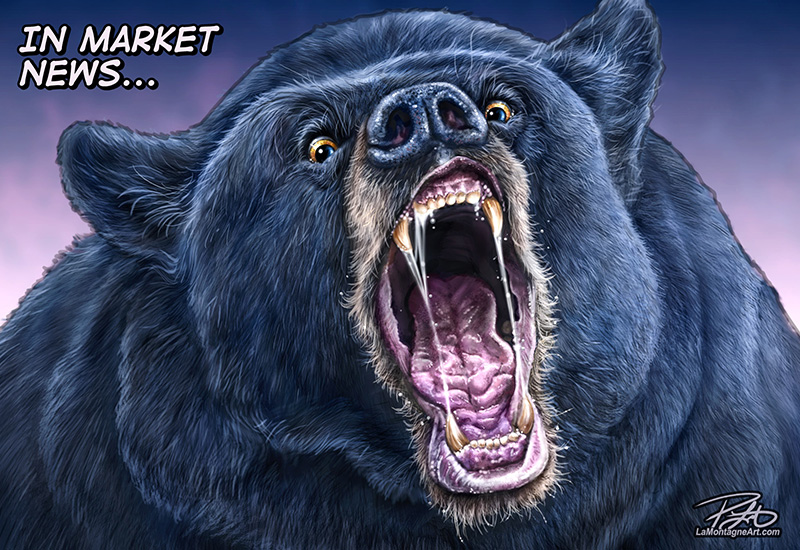 I’ve used a polar bear or two in cartoons about climate change. And when Kevin Costner was the parade marshal for the Calgary Stampede in 2022, I used my portrait of his Yellowstone character, John Dutton, in a cartoon.
I’ve used a polar bear or two in cartoons about climate change. And when Kevin Costner was the parade marshal for the Calgary Stampede in 2022, I used my portrait of his Yellowstone character, John Dutton, in a cartoon.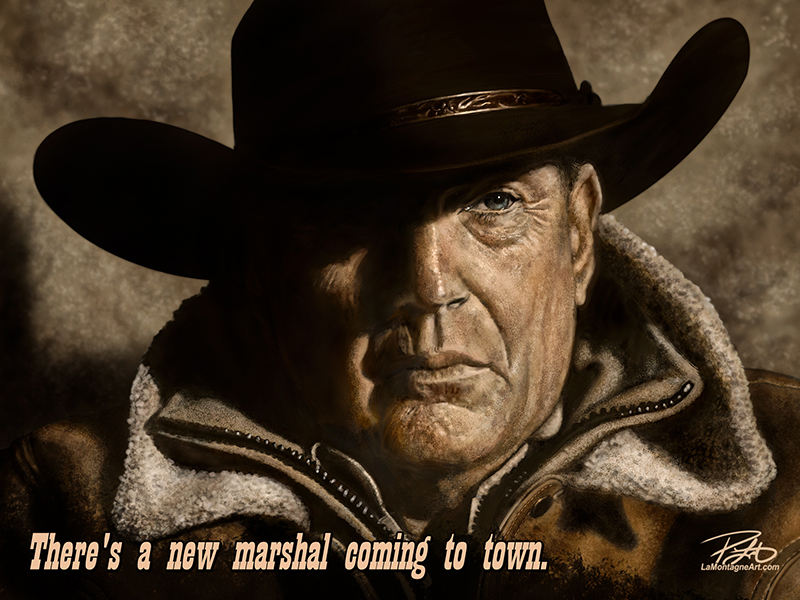 The Calgary Herald currently runs my cartoons more than any other daily newspaper in Canada, and they’ve been publishing my work for more than twenty years. How often, depends on how the editor of the day feels about my work in general. Everyone has their favourite artists.
The Calgary Herald currently runs my cartoons more than any other daily newspaper in Canada, and they’ve been publishing my work for more than twenty years. How often, depends on how the editor of the day feels about my work in general. Everyone has their favourite artists.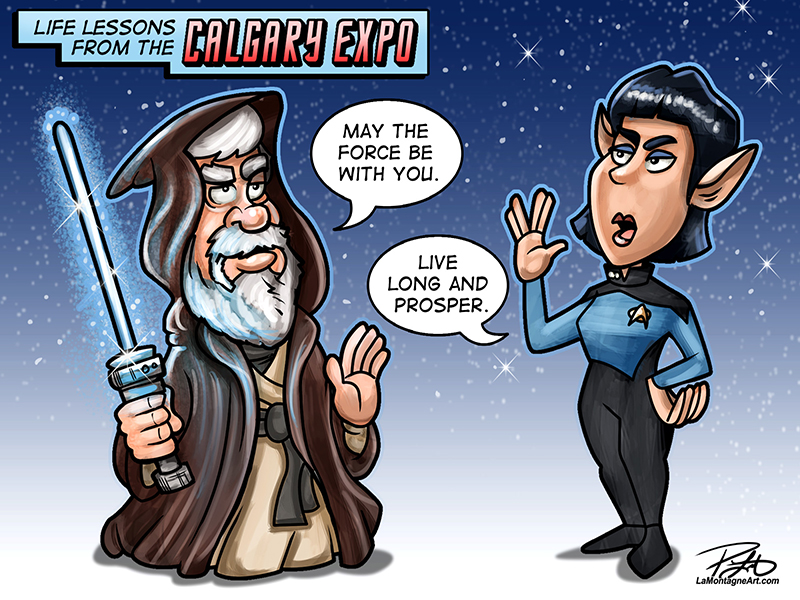 But it’s also fair comment about a positive event that brings a lot of people and revenue to the city. Though many refer to it as Comic-Con, it is so much more than that, a massive fan experience with 100,000 people coming through this show in four days. Some are there to get a celebrity photo or signature, others to add to their pop culture or art collections, and many come for the cosplay, to dress up and let their freak flags fly. I suspect most people come for the spectacle, to run away with the circus for a few days.
But it’s also fair comment about a positive event that brings a lot of people and revenue to the city. Though many refer to it as Comic-Con, it is so much more than that, a massive fan experience with 100,000 people coming through this show in four days. Some are there to get a celebrity photo or signature, others to add to their pop culture or art collections, and many come for the cosplay, to dress up and let their freak flags fly. I suspect most people come for the spectacle, to run away with the circus for a few days.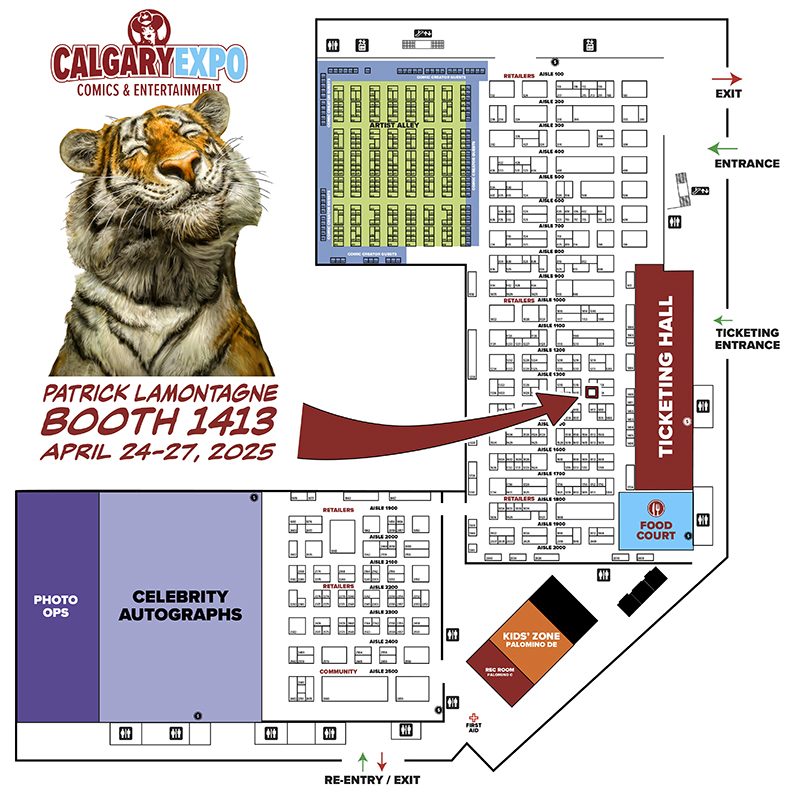 If you’re coming to the Calgary Expo, I’ll be chained to my booth from opening Thursday to closing on Sunday. I set it up yesterday, and I’m ready for the chaos. Come by and say Hello!
If you’re coming to the Calgary Expo, I’ll be chained to my booth from opening Thursday to closing on Sunday. I set it up yesterday, and I’m ready for the chaos. Come by and say Hello!


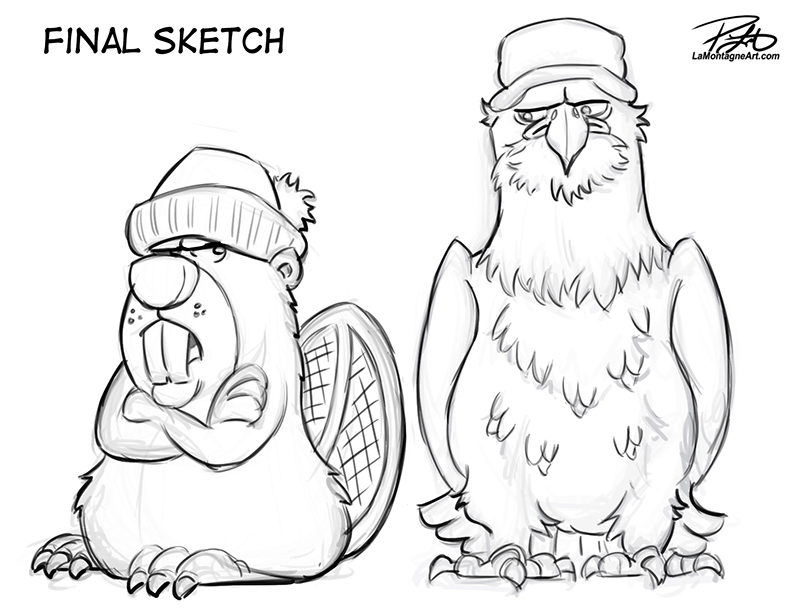 Each week, I draw five or six syndicated editorial cartoons. I follow regional, provincial, national and international news and draw illustrated commentary on prominent stories. Many of my weekly clients across Canada only run my cartoons in their publications, some for over a decade. Other clients, especially daily papers, will pick and choose from submissions from several cartoonists. Despite the belief that journalism is unbiased, it most certainly is not. Some newspapers lean left while others lean right.
Each week, I draw five or six syndicated editorial cartoons. I follow regional, provincial, national and international news and draw illustrated commentary on prominent stories. Many of my weekly clients across Canada only run my cartoons in their publications, some for over a decade. Other clients, especially daily papers, will pick and choose from submissions from several cartoonists. Despite the belief that journalism is unbiased, it most certainly is not. Some newspapers lean left while others lean right.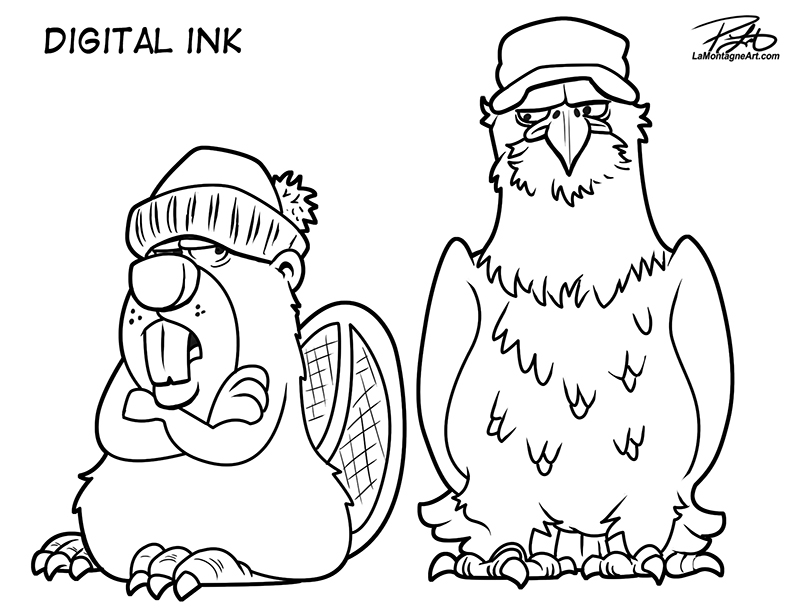 Years ago, I recall that somebody in Canmore came up with a proposal that each business in the community should contribute to a tourism promotion fee. Some businesses complained they shouldn’t have to because they weren’t in the tourism business.
Years ago, I recall that somebody in Canmore came up with a proposal that each business in the community should contribute to a tourism promotion fee. Some businesses complained they shouldn’t have to because they weren’t in the tourism business.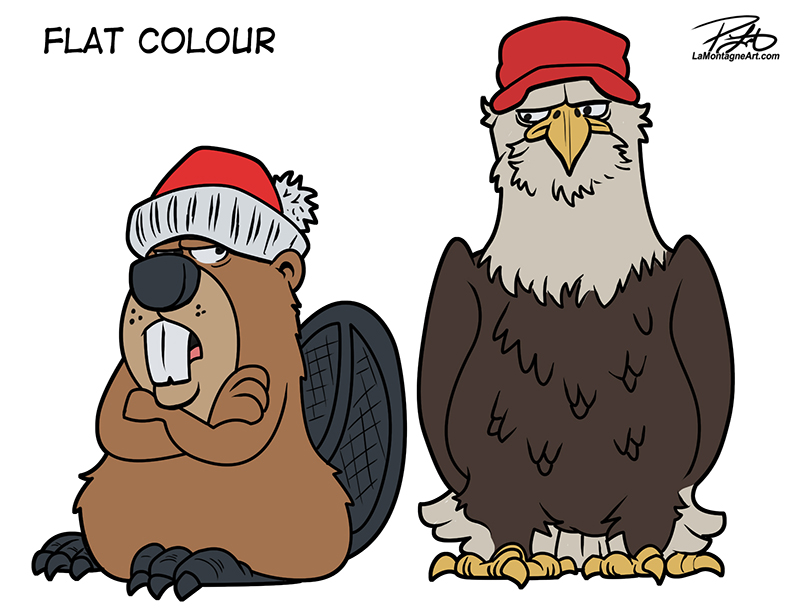 Canada and the United States have had a unique, enviable, and friendly relationship for longer than any two countries. We’ve often referred to each other as family. We’ve had our ups and downs; every relationship does, but it has always endured.
Canada and the United States have had a unique, enviable, and friendly relationship for longer than any two countries. We’ve often referred to each other as family. We’ve had our ups and downs; every relationship does, but it has always endured.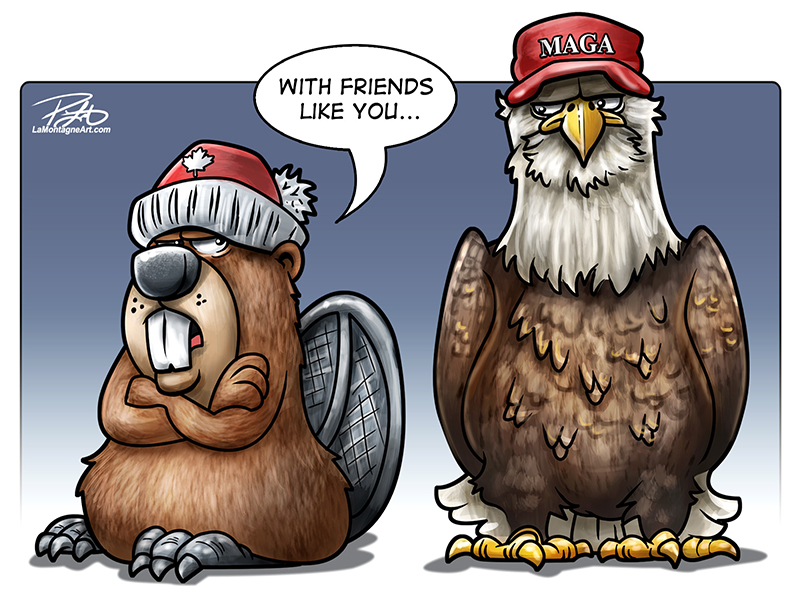 On Saturday, I paid my deposit and applied for the Banff Christmas Market this year. While anything can happen between now and the end of the year, I’m already lowering expectations. I’m currently sourcing and buying stock for the Calgary Expo at the end of April, but I’m no longer planning on some products. I don’t think people will have money to spend on luxuries, and my work certainly qualifies.
On Saturday, I paid my deposit and applied for the Banff Christmas Market this year. While anything can happen between now and the end of the year, I’m already lowering expectations. I’m currently sourcing and buying stock for the Calgary Expo at the end of April, but I’m no longer planning on some products. I don’t think people will have money to spend on luxuries, and my work certainly qualifies.
 New subscribers usually follow me for my
New subscribers usually follow me for my  On that list of celebrity passings, for the ones that didn’t say, I found myself looking up their causes of death. Mostly, it was the usual suspects I don’t need to list. They’re the indignities of disease and illness that can strike any time but become more likely the longer we’re here.
On that list of celebrity passings, for the ones that didn’t say, I found myself looking up their causes of death. Mostly, it was the usual suspects I don’t need to list. They’re the indignities of disease and illness that can strike any time but become more likely the longer we’re here. Though clichés and platitudes, there are lessons I clearly haven’t yet learned, that I’d do well to remember heading into 2025. Perhaps they’ll give you something to consider as well.
Though clichés and platitudes, there are lessons I clearly haven’t yet learned, that I’d do well to remember heading into 2025. Perhaps they’ll give you something to consider as well.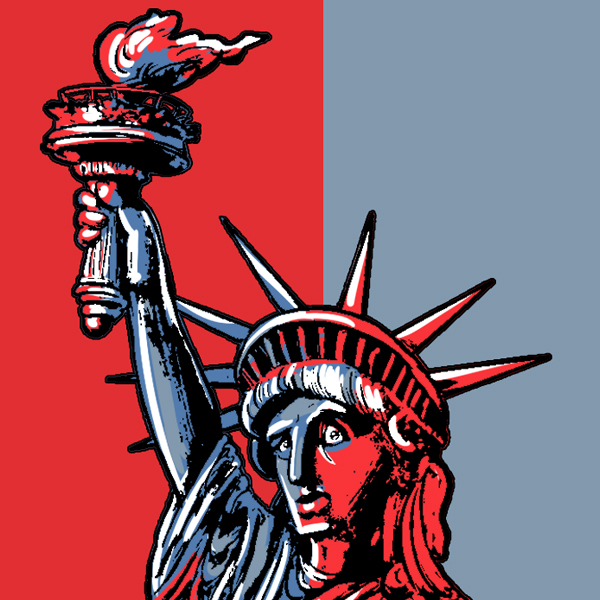
 I haven’t been sleeping well, and I’m sure I’m not the only one.
I haven’t been sleeping well, and I’m sure I’m not the only one.
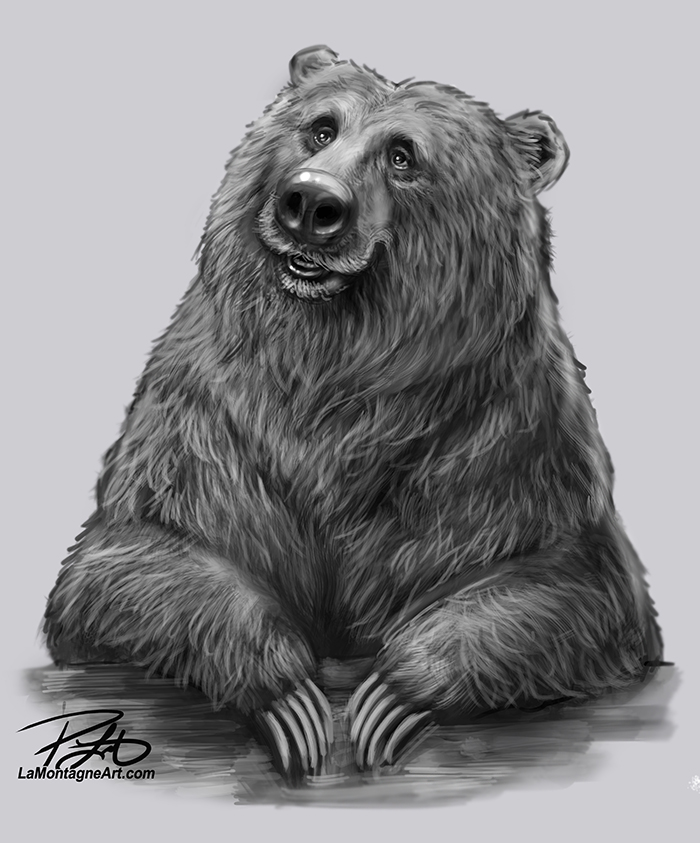 Over the past week, I’ve received a few
Over the past week, I’ve received a few 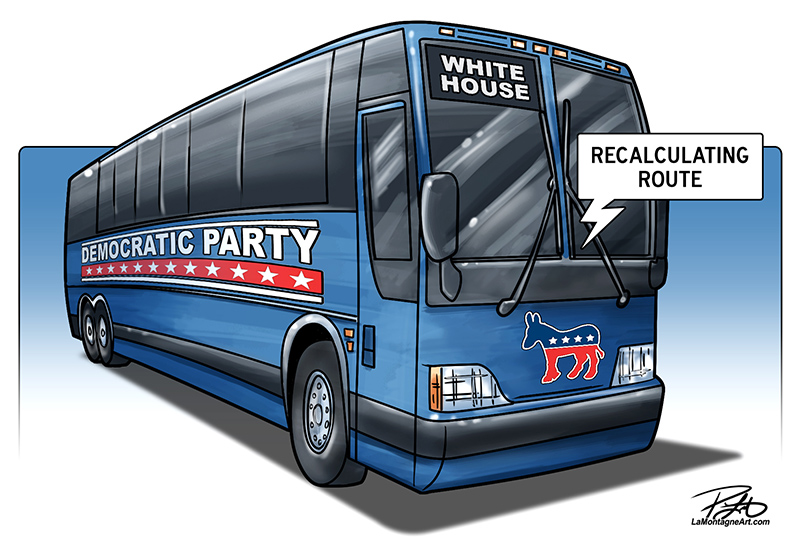 This past Sunday, I had drawn two cartoons in the morning and was going to paint all afternoon. Then President Biden announced he was no longer running for re-election, and suddenly, I had to draw a new cartoon for Monday morning. While drawing each cartoon takes a few hours or more, I first have to come up with the idea, which also takes time.
This past Sunday, I had drawn two cartoons in the morning and was going to paint all afternoon. Then President Biden announced he was no longer running for re-election, and suddenly, I had to draw a new cartoon for Monday morning. While drawing each cartoon takes a few hours or more, I first have to come up with the idea, which also takes time.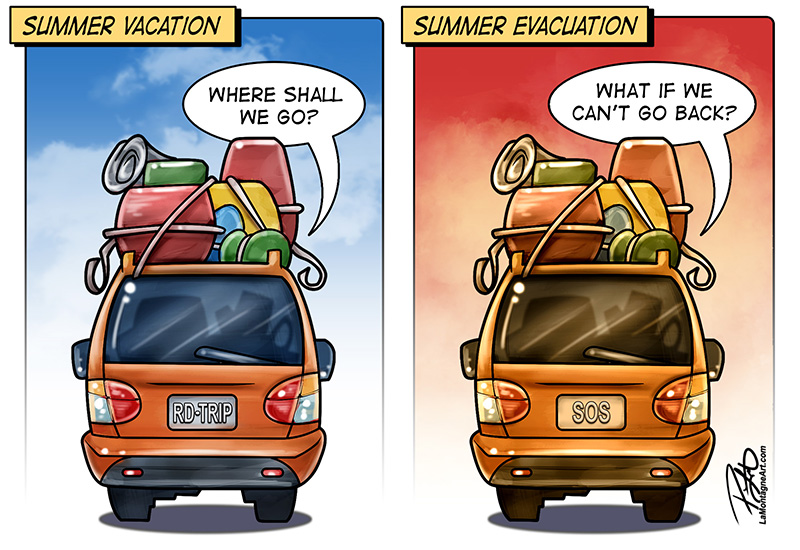 Adjusting course, I planned to paint all day Tuesday but woke to find out that the town of Jasper had evacuated for a wildfire. Suddenly, I had to scrap the cartoon I’d already drawn and sent Monday afternoon for the
Adjusting course, I planned to paint all day Tuesday but woke to find out that the town of Jasper had evacuated for a wildfire. Suddenly, I had to scrap the cartoon I’d already drawn and sent Monday afternoon for the 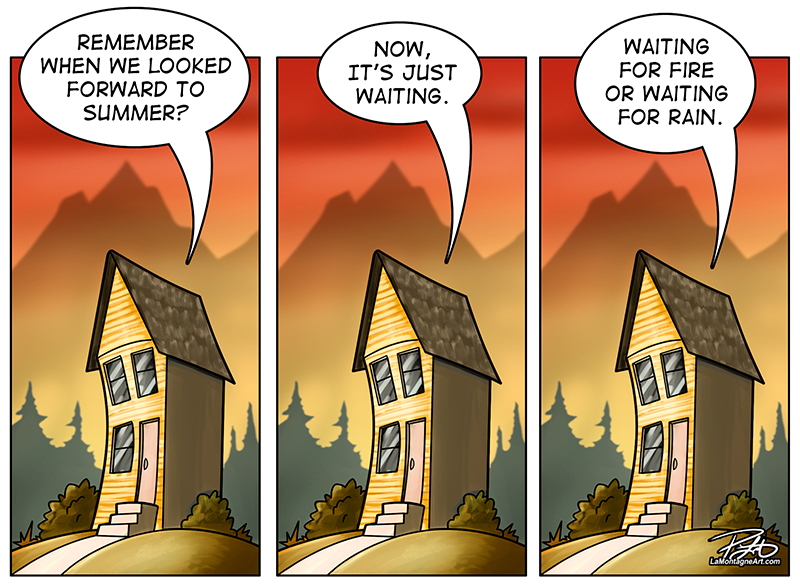 Having been through an evacuation in 2013 (water, not fire), and the odds are a little too good we may one day go through that again; I feel for those people. It’s a frightening thing to leave your home and not know if will be there when you get back. As the fire has breached the town of Jasper, and structures are burning, some people will lose everything. What makes it worse is when insensitive, small-minded keyboard warriors post stupid things like, “It’s only stuff.”
Having been through an evacuation in 2013 (water, not fire), and the odds are a little too good we may one day go through that again; I feel for those people. It’s a frightening thing to leave your home and not know if will be there when you get back. As the fire has breached the town of Jasper, and structures are burning, some people will lose everything. What makes it worse is when insensitive, small-minded keyboard warriors post stupid things like, “It’s only stuff.”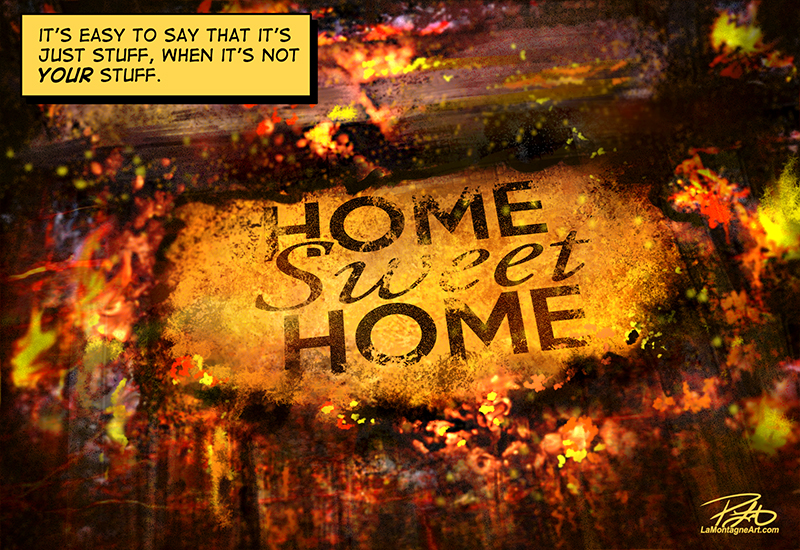 I have several paintings in progress, a few I expected to be done by now, which is frustrating. Because each features several animals, they take much longer, contributing to the feeling I’m not producing enough finished work.
I have several paintings in progress, a few I expected to be done by now, which is frustrating. Because each features several animals, they take much longer, contributing to the feeling I’m not producing enough finished work.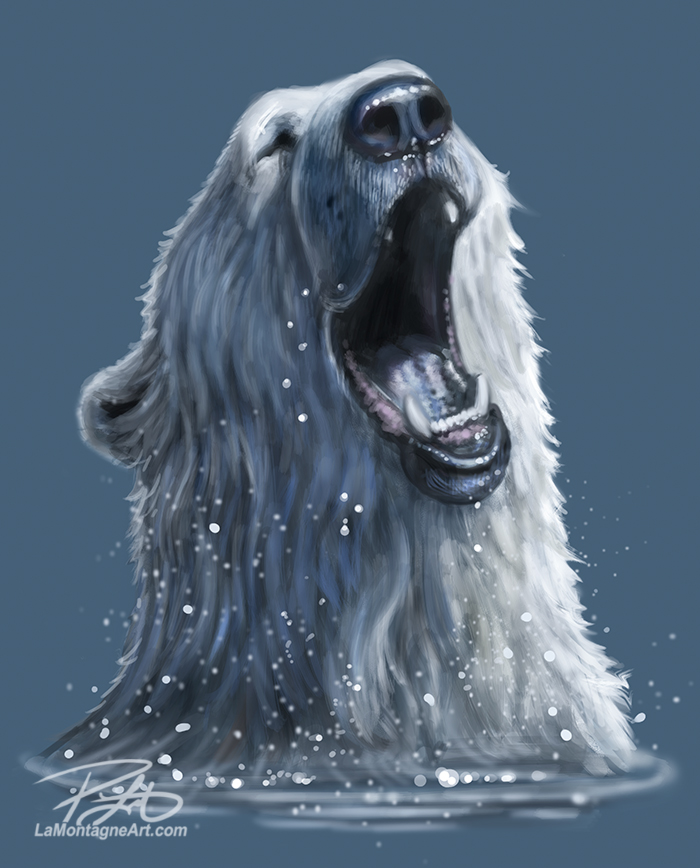 In the meantime, I hope you’re having a good summer despite the oppressive heat and wildfire smoke in some places. After a cool and comfortable rainy June, our July has sucked up all the moisture, and our brown grass and crispy trees could use some precipitation.
In the meantime, I hope you’re having a good summer despite the oppressive heat and wildfire smoke in some places. After a cool and comfortable rainy June, our July has sucked up all the moisture, and our brown grass and crispy trees could use some precipitation.

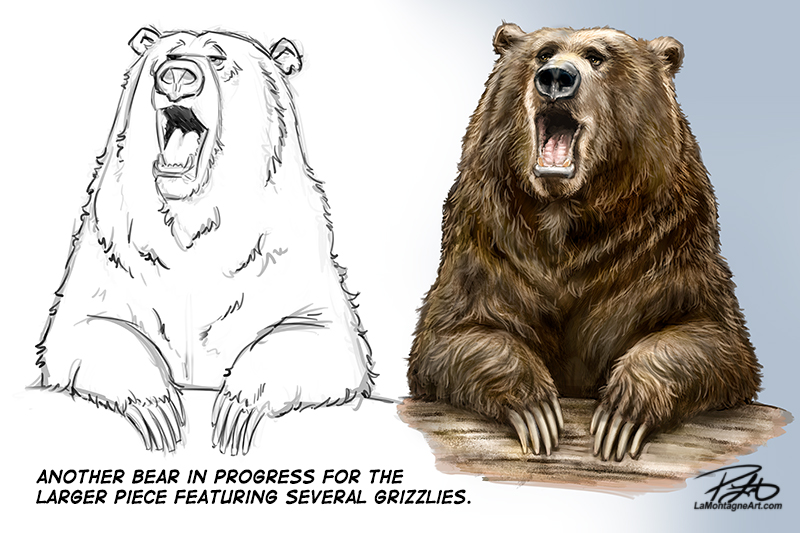 The paintings I was already working on need to be done by the end of next month so I can order puzzles and products for the markets. Then there are the sketches, paintings and writing for the book, six editorial
The paintings I was already working on need to be done by the end of next month so I can order puzzles and products for the markets. Then there are the sketches, paintings and writing for the book, six editorial 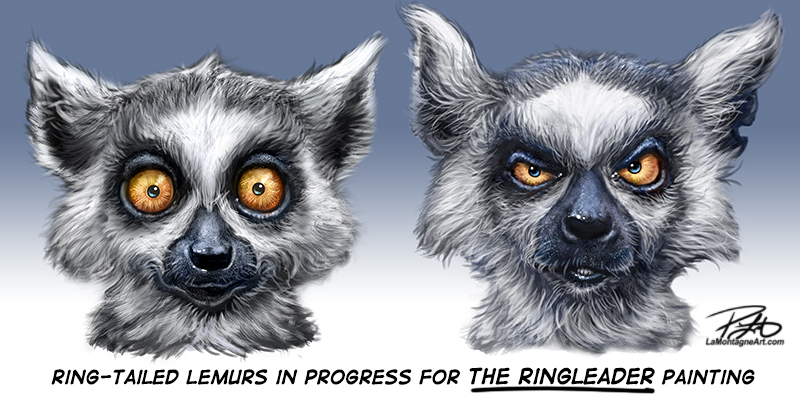 Sure, I’ll bitch about being too busy sometimes, but I chose this. Though the landscape will change, as will the work, and it’s unlikely ever to get easier, I plan to create art as long as possible. I don’t know if I could do anything else, now.
Sure, I’ll bitch about being too busy sometimes, but I chose this. Though the landscape will change, as will the work, and it’s unlikely ever to get easier, I plan to create art as long as possible. I don’t know if I could do anything else, now.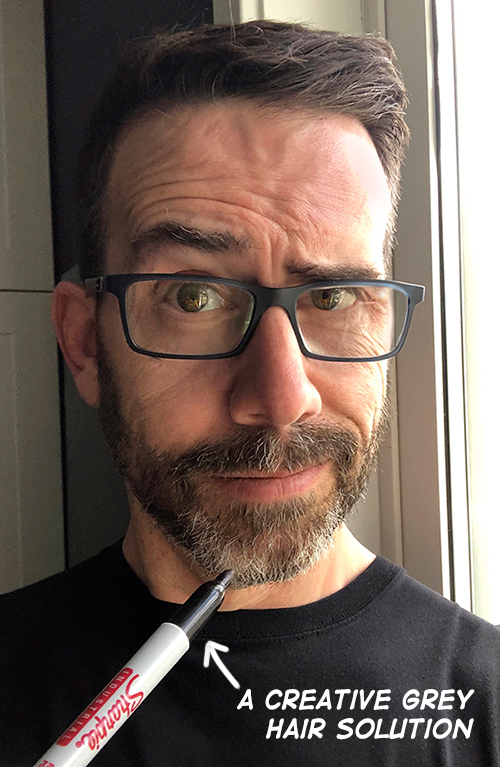 I’m grateful for so many of you who follow my work, comment on my posts or write emails, sending me wildlife pictures and thoughts about something I’ve shared or the artwork in general. With so much content available to us, that anyone volunteers to receive my
I’m grateful for so many of you who follow my work, comment on my posts or write emails, sending me wildlife pictures and thoughts about something I’ve shared or the artwork in general. With so much content available to us, that anyone volunteers to receive my
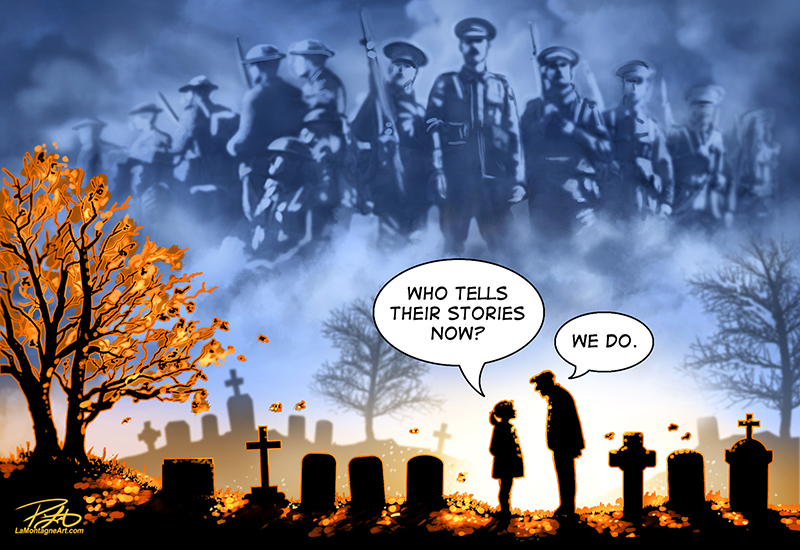
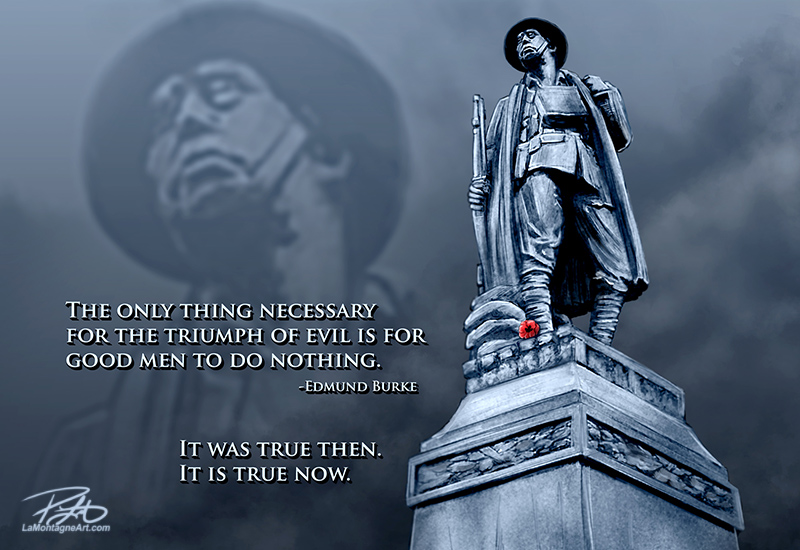 On occasion, I focus less on veterans of the wars and more on those who currently serve. And throughout the year, I take every opportunity to draw cartoons intended to shame our political leadership into less talk and more action.
On occasion, I focus less on veterans of the wars and more on those who currently serve. And throughout the year, I take every opportunity to draw cartoons intended to shame our political leadership into less talk and more action.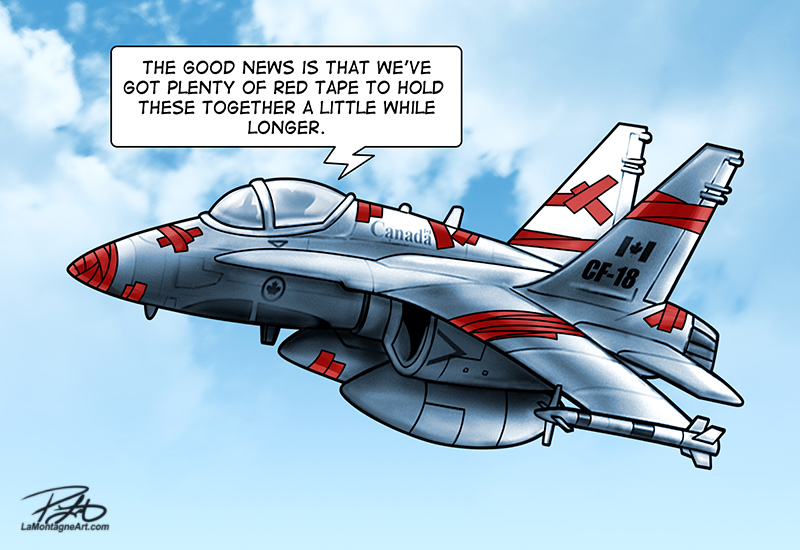 From decades-long procurement problems and endless red tape tying up much-needed equipment replacement to an enlistment shortfall that gets worse each year, the Canadian Armed Forces has its issues. Stains and scandals are public record, and for those, they’re held to account.
From decades-long procurement problems and endless red tape tying up much-needed equipment replacement to an enlistment shortfall that gets worse each year, the Canadian Armed Forces has its issues. Stains and scandals are public record, and for those, they’re held to account.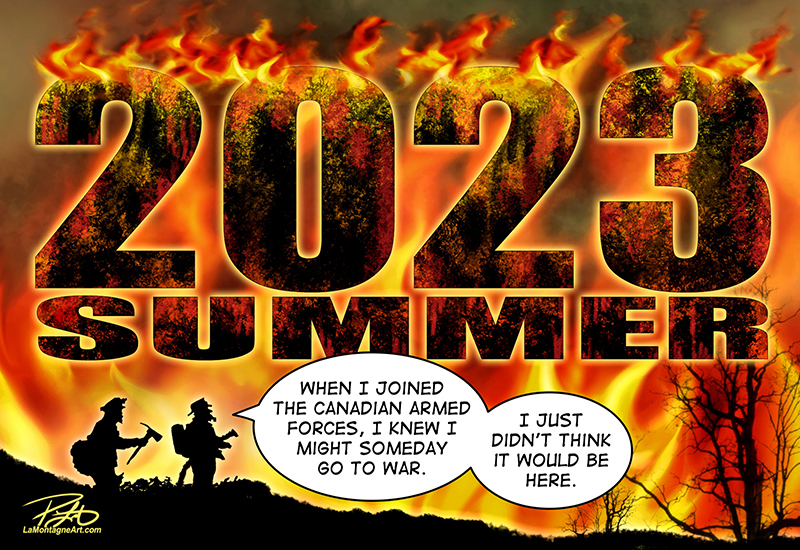 Just this year, the military was tasked with emergency deployments when wildfires threatened several communities. They’ve rendered such assistance in countless natural disasters across Canada over the years. Given our changing climate, Canada will require more of their aid in the future.
Just this year, the military was tasked with emergency deployments when wildfires threatened several communities. They’ve rendered such assistance in countless natural disasters across Canada over the years. Given our changing climate, Canada will require more of their aid in the future.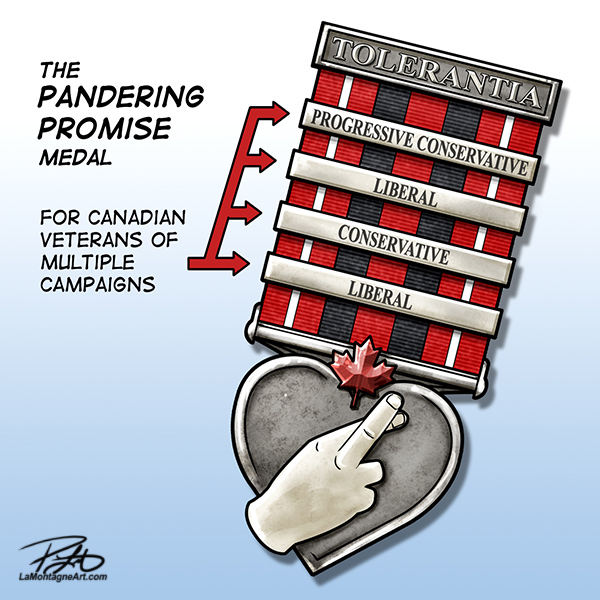 Politicians on all sides talk a good game about supporting our men and women in uniform when it buys them votes, only to slash budgets when they no longer benefit from the optics. The men and women who serve have surrendered their right to openly complain about the government, something the rest of us take for granted.
Politicians on all sides talk a good game about supporting our men and women in uniform when it buys them votes, only to slash budgets when they no longer benefit from the optics. The men and women who serve have surrendered their right to openly complain about the government, something the rest of us take for granted.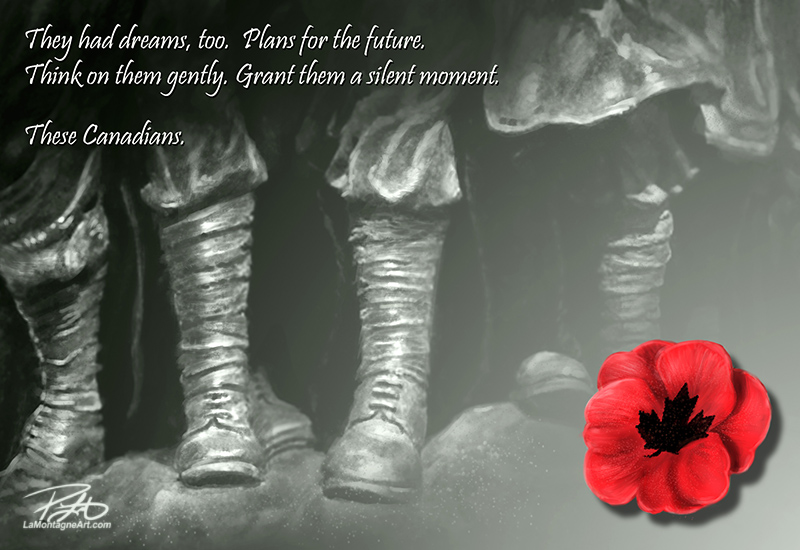 Yes, think of those who have fallen in service of our country. Remember them and their sacrifice, so that history isn’t allowed to repeat.
Yes, think of those who have fallen in service of our country. Remember them and their sacrifice, so that history isn’t allowed to repeat.
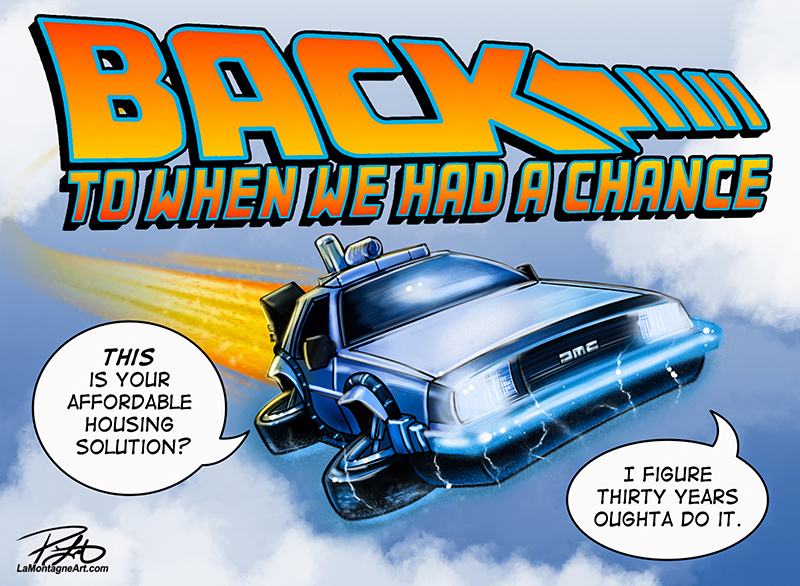
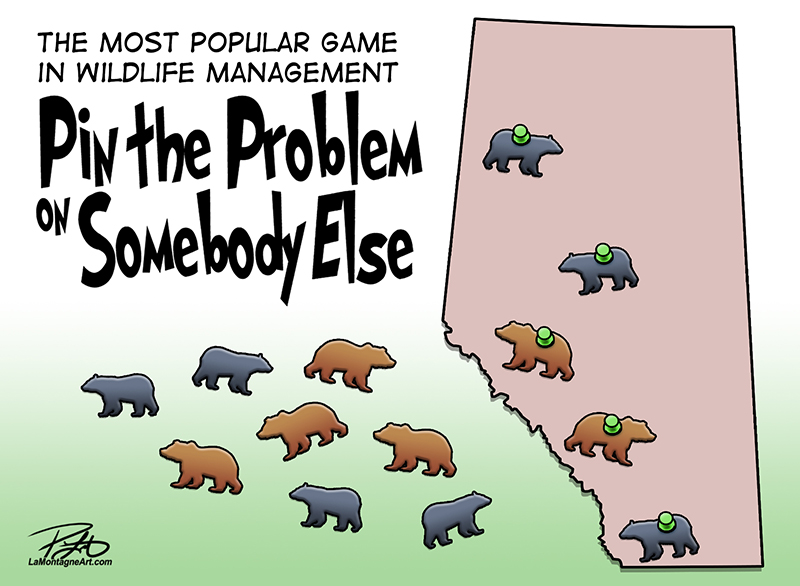
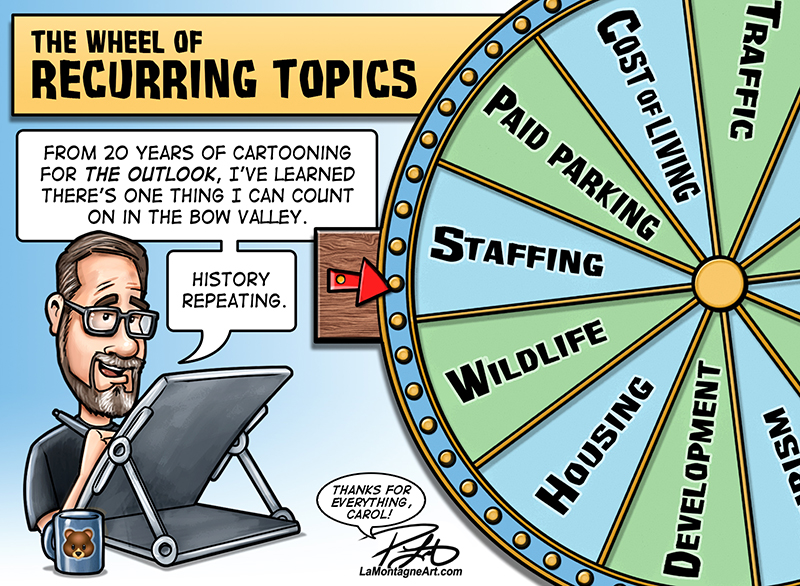
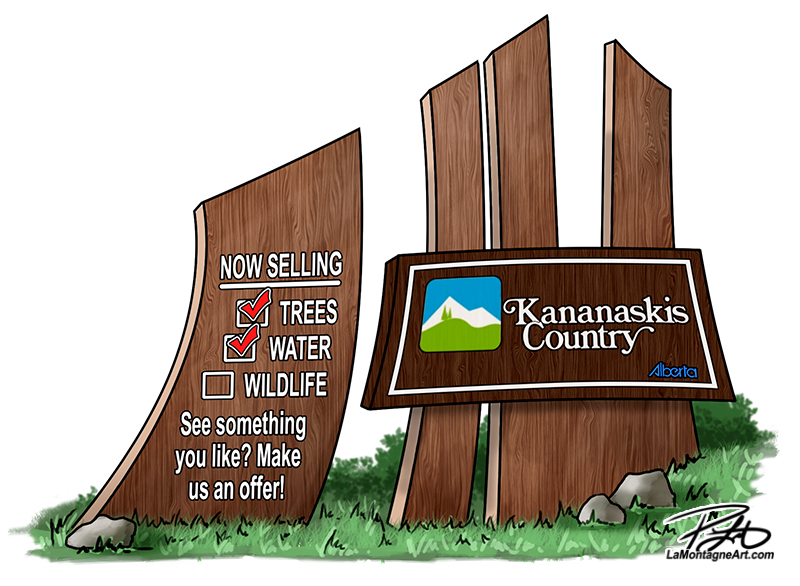 A former Canmore mayor once joked he was disappointed I hadn’t drawn a cartoon of him. I told him that was probably a good thing, but if it had been that important to him, he should have embezzled some money or participated in some other scandal. On the other side of that, a reporter once told me that a former Banff mayor was thoroughly irritated when I drew a caricature of him in a cartoon. So, be careful what you wish for.
A former Canmore mayor once joked he was disappointed I hadn’t drawn a cartoon of him. I told him that was probably a good thing, but if it had been that important to him, he should have embezzled some money or participated in some other scandal. On the other side of that, a reporter once told me that a former Banff mayor was thoroughly irritated when I drew a caricature of him in a cartoon. So, be careful what you wish for.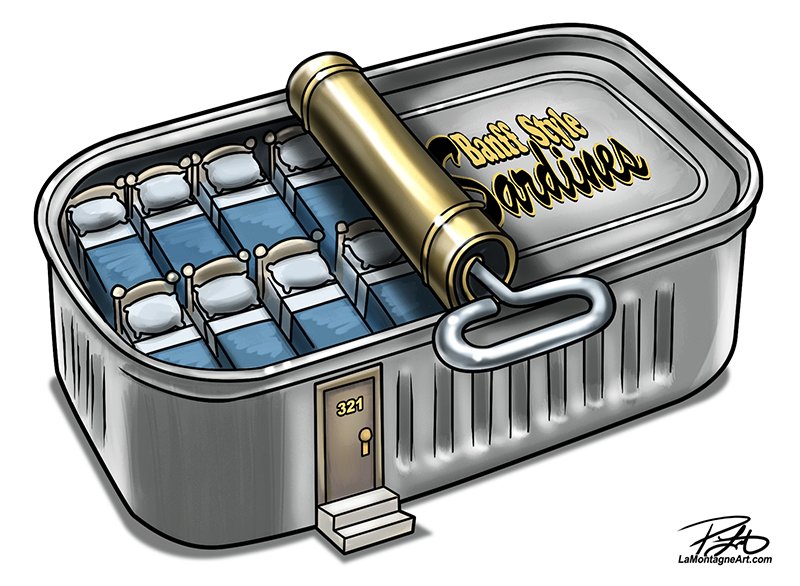
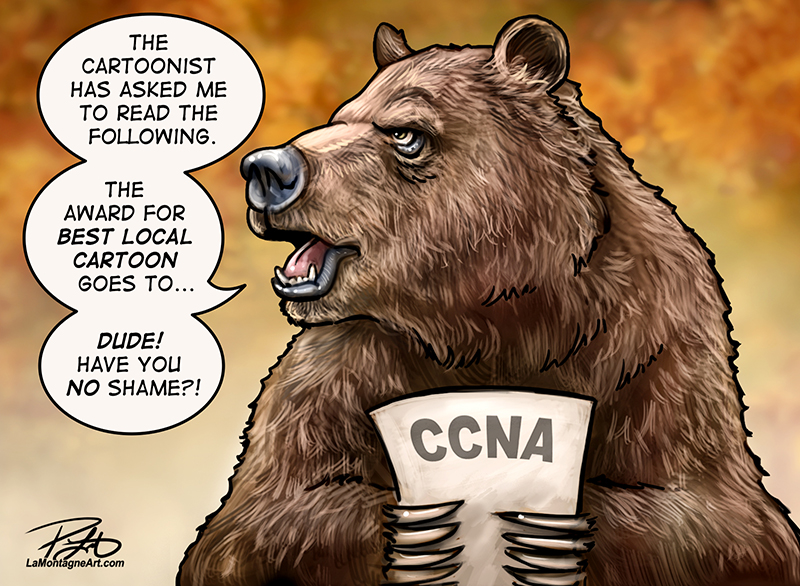 Cheers,
Cheers,
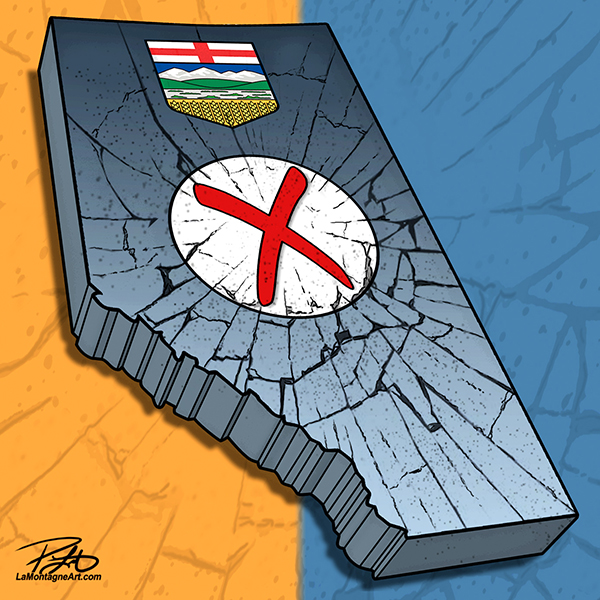
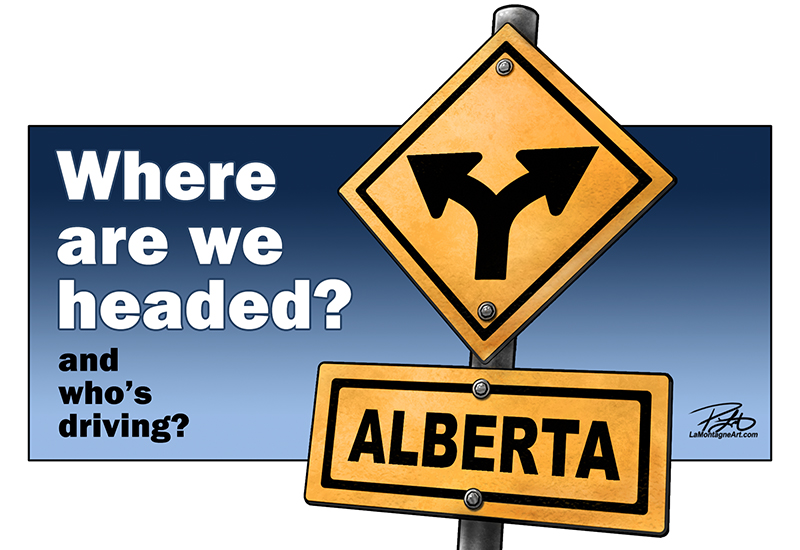
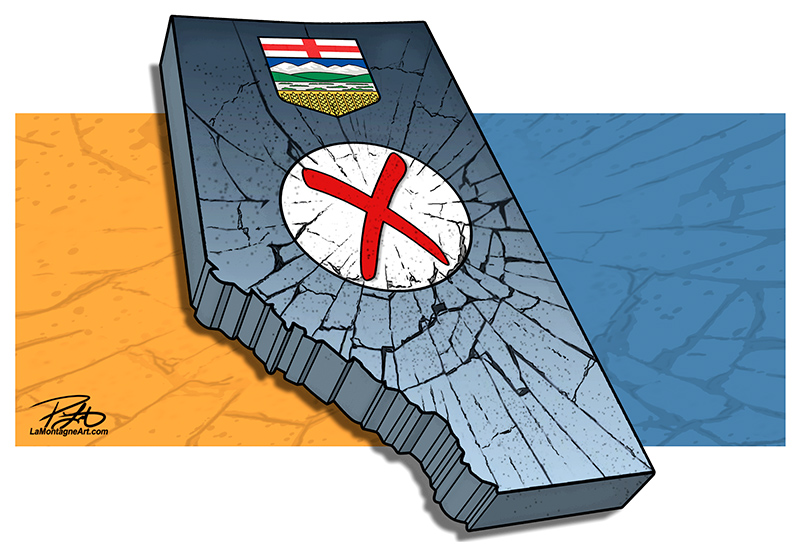 I could have written this before election day to encourage people to get out and make a difference, but to imagine I have that much influence over anyone would be arrogant.
I could have written this before election day to encourage people to get out and make a difference, but to imagine I have that much influence over anyone would be arrogant.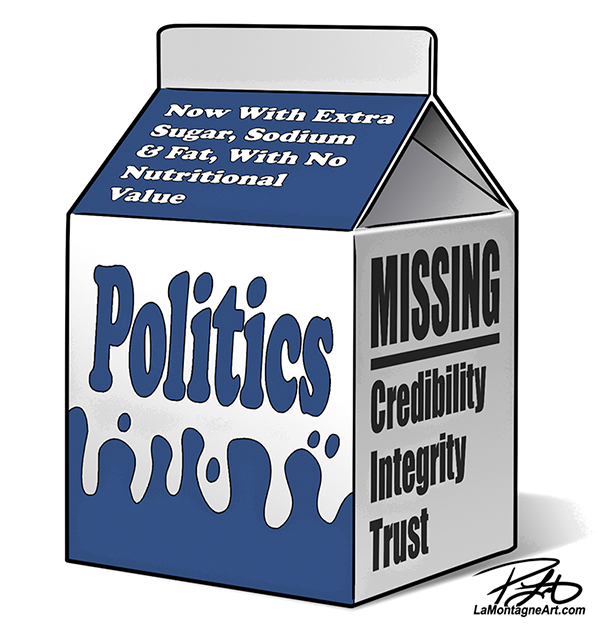
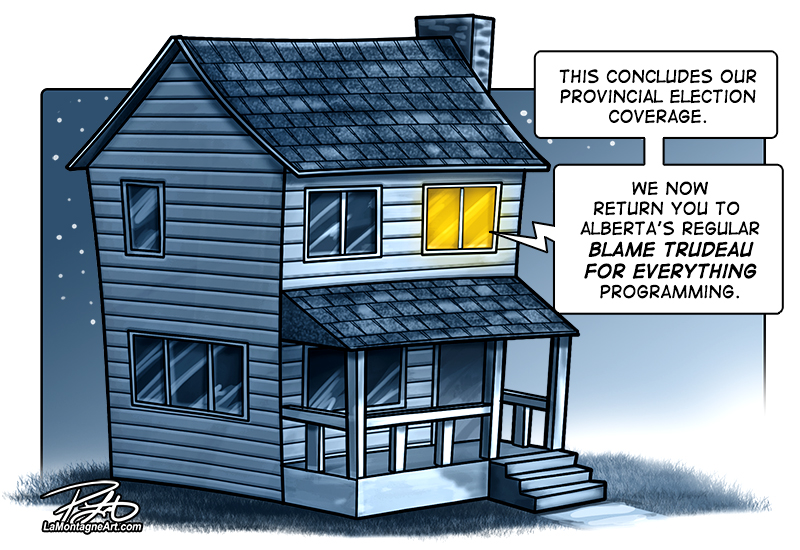 ____
____
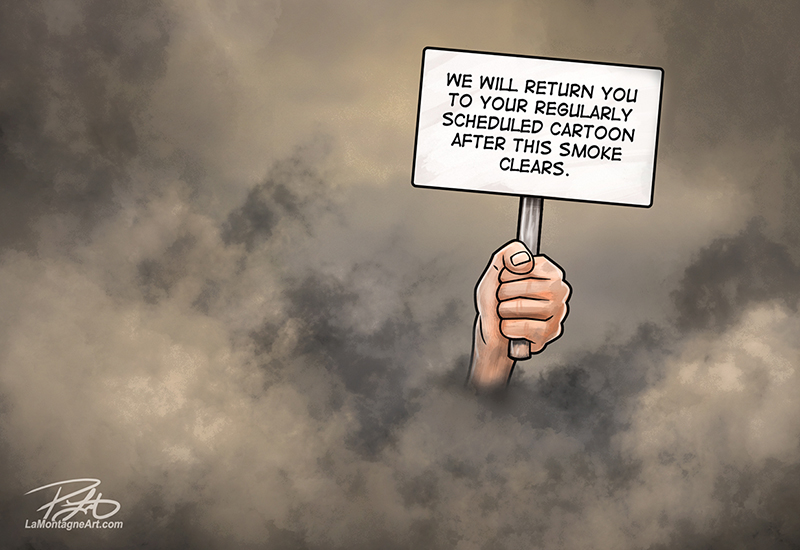
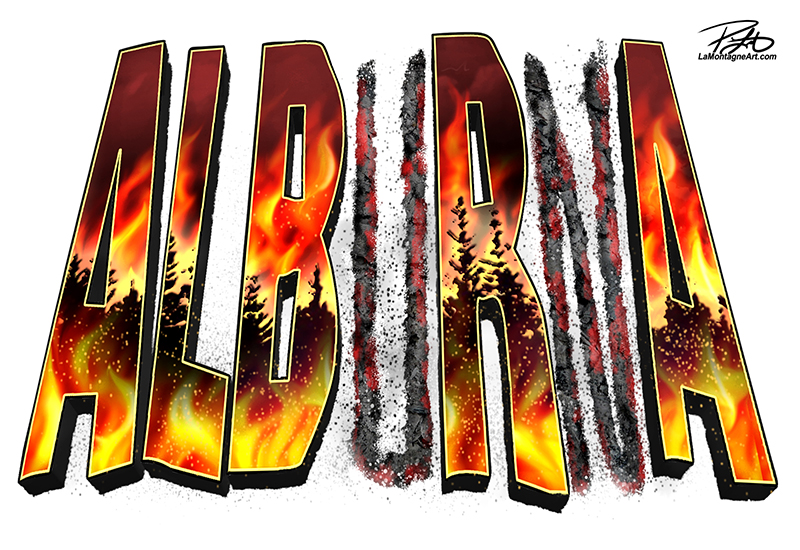
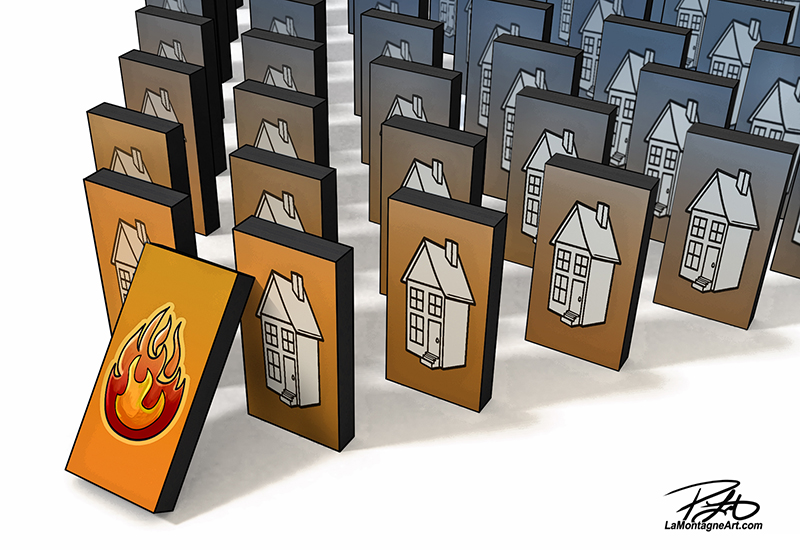 Even with that small level of experience, I can’t imagine the stress these recent fire evacuees are enduring. Two weeks out of your home, watching the fires on the news as they get closer, often from hours away in shelters or homes in unfamiliar communities, not knowing when or if you’ll be able to return.
Even with that small level of experience, I can’t imagine the stress these recent fire evacuees are enduring. Two weeks out of your home, watching the fires on the news as they get closer, often from hours away in shelters or homes in unfamiliar communities, not knowing when or if you’ll be able to return.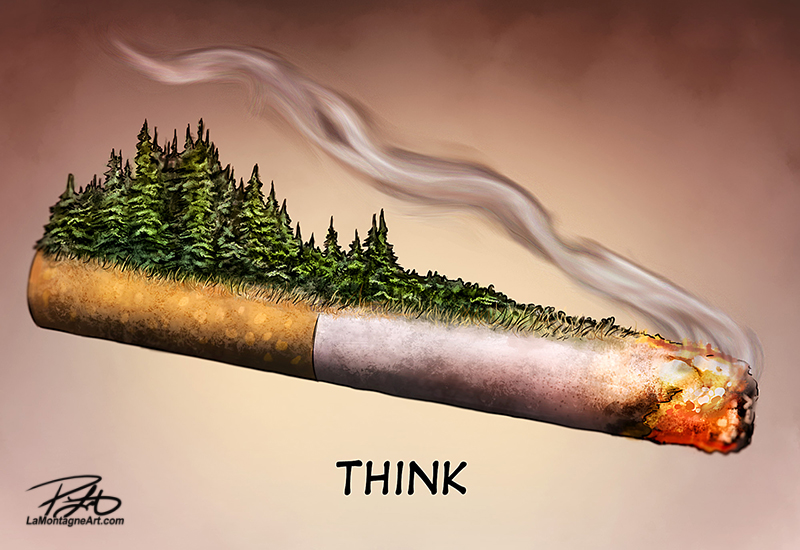 Wildfires are destructive enough. But what bothers me most is how so many use these disasters to further their agendas, political or otherwise.
Wildfires are destructive enough. But what bothers me most is how so many use these disasters to further their agendas, political or otherwise.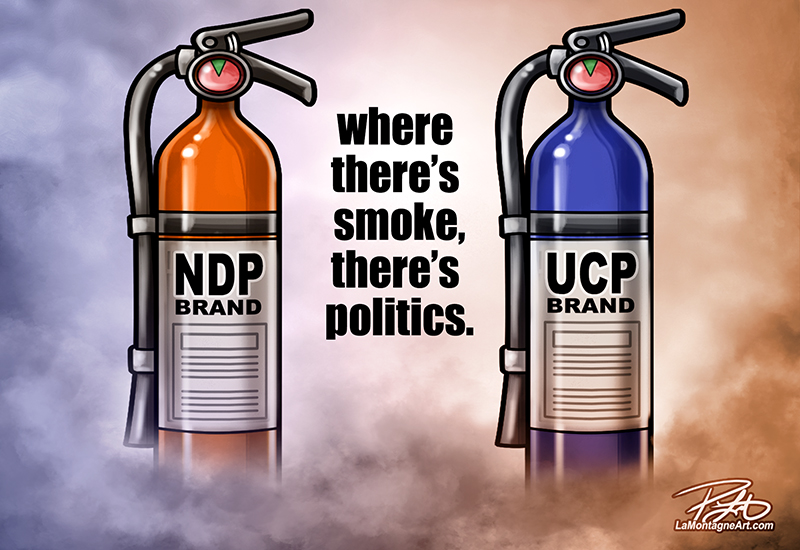 Some supporters of BOTH political parties accuse the other of deliberately starting these fires to win votes. People in the energy sector are accusing environmentalists of starting fires to destroy the oil patch. Climate change activists use the fires to trumpet their agendas, and deniers share cherry-picked links to debunk them.
Some supporters of BOTH political parties accuse the other of deliberately starting these fires to win votes. People in the energy sector are accusing environmentalists of starting fires to destroy the oil patch. Climate change activists use the fires to trumpet their agendas, and deniers share cherry-picked links to debunk them.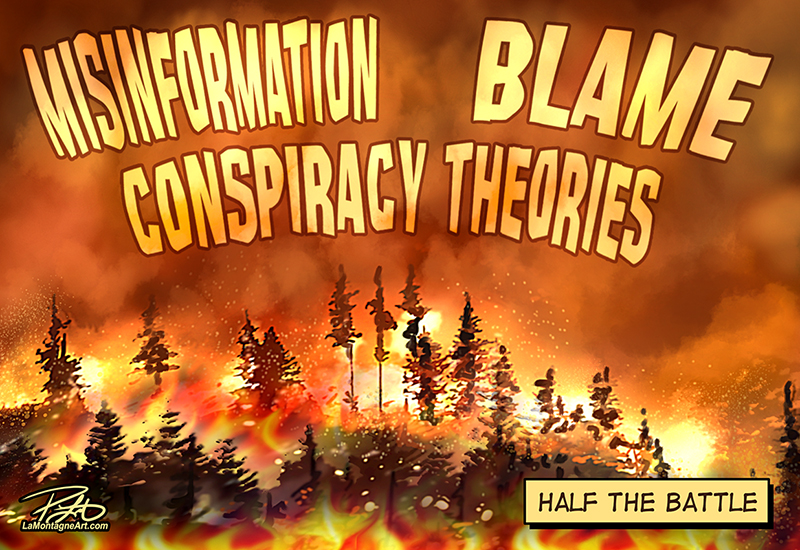 Amid all this noise, people out of their homes haven’t had a good night’s sleep in weeks, they’re unable to work, their kids are out of school, and whatever problems they already had are compounded. They’re scared, vulnerable, and feeling helpless. Their world is falling apart, and they can do nothing about it.
Amid all this noise, people out of their homes haven’t had a good night’s sleep in weeks, they’re unable to work, their kids are out of school, and whatever problems they already had are compounded. They’re scared, vulnerable, and feeling helpless. Their world is falling apart, and they can do nothing about it.